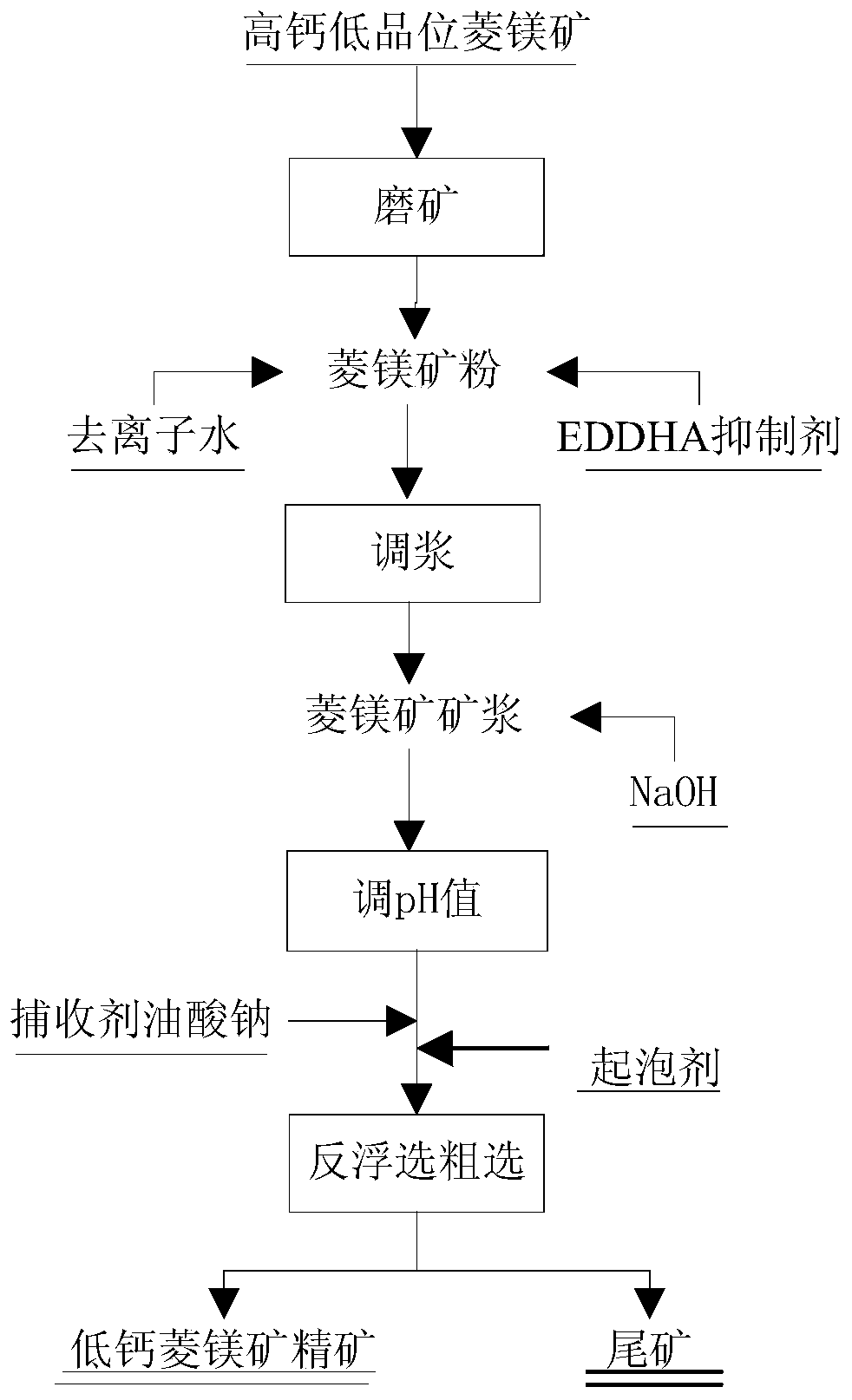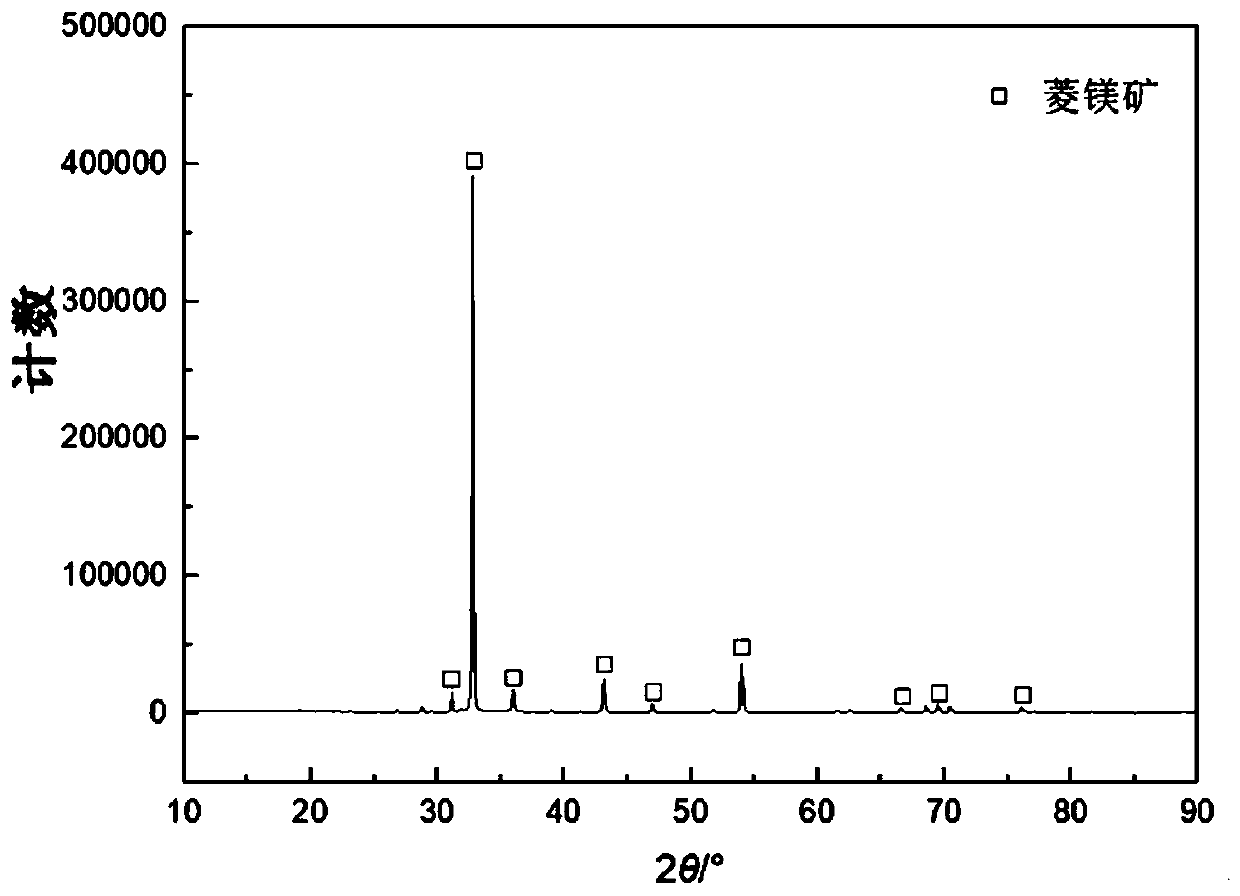Method for reverse flotation decalcification of magnesite by adopting EDDHA inhibiting agents
A magnesite and inhibitor technology, applied in the field of magnesite beneficiation and purification technology, achieves the effects of high content, shortened flotation decalcification process, and strong selective inhibition
- Summary
- Abstract
- Description
- Claims
- Application Information
AI Technical Summary
Problems solved by technology
Method used
Image
Examples
Embodiment 1
[0040] A kind of method that adopts EDDHA inhibitor to carry out the method for decalcification of magnesite reverse flotation, its flow chart is shown in figure 1 , including the following steps:
[0041] Step 1: Grinding
[0042] The raw material of high-calcium and low-grade magnesite is crushed and ball-milled to obtain magnesite powder; wherein, in the magnesite powder, the mass of magnesite powder with a particle size of less than 74 μm accounts for 65% of the total mass of magnesite powder;
[0043] Step 2: Blending
[0044] Put the magnesite powder with a particle size of less than 74 μm and accounting for 65% of the total magnesite powder mass in a hanging tank flotation machine, add deionized water and EDDHA inhibitor, wherein, according to the solid-to-liquid ratio, the EDDHA inhibitor : magnesite pulp=60mg: 1L, and mix evenly, adjust slurry to obtain magnesite pulp; wherein, the mass concentration of magnesite in the magnesite pulp is 10%;
[0045] Step 3: Rever...
Embodiment 2
[0055] A kind of method that adopts EDDHA inhibitor to carry out the method for decalcification of magnesite reverse flotation, its flow chart is shown in figure 1 , including the following steps:
[0056] Step 1: Grinding
[0057] The raw material of high-calcium and low-grade magnesite is crushed and ball-milled to obtain magnesite powder; among them, magnesite powder with a particle size of less than 74 μm accounts for 75% of the total magnesite powder;
[0058] Step 2: Blending
[0059] Put the magnesite powder with a particle size of less than 74 μm and accounting for 75% of the total magnesite powder in the hanging tank type flotation machine, add deionized water and EDDHA inhibitor, wherein, according to the solid-to-liquid ratio, the EDDHA inhibitor : magnesite pulp=70mg: 1L, and mix evenly, adjust slurry, obtain magnesite pulp; wherein, the mass concentration of magnesite in the magnesite pulp is 15%;
[0060] Step 3: Reverse Flotation Decalcification
[0061] At ...
Embodiment 3
[0065] A kind of method that adopts EDDHA inhibitor to carry out the method for decalcification of magnesite reverse flotation, its flow chart is shown in figure 1 , including the following steps:
[0066] Step 1: Grinding
[0067] The raw material of high-calcium and low-grade magnesite is crushed and ball-milled to obtain magnesite powder; among them, magnesite powder with a particle size of less than 74 μm accounts for 85% of the total magnesite powder;
[0068] Step 2: Blending
[0069] Put the magnesite powder with a particle size of less than 74 μm and accounting for 85% of the total magnesite powder in the hanging tank type flotation machine, add deionized water and EDDHA inhibitor, wherein, according to the solid-to-liquid ratio, the EDDHA inhibitor : magnesite pulp=80mg: 1L, and mix evenly, adjust slurry, obtain magnesite pulp; wherein, the mass concentration of magnesite in the magnesite pulp is 20%;
[0070] Step 3: Reverse Flotation Decalcification
[0071] At ...
PUM
 Login to View More
Login to View More Abstract
Description
Claims
Application Information
 Login to View More
Login to View More - R&D
- Intellectual Property
- Life Sciences
- Materials
- Tech Scout
- Unparalleled Data Quality
- Higher Quality Content
- 60% Fewer Hallucinations
Browse by: Latest US Patents, China's latest patents, Technical Efficacy Thesaurus, Application Domain, Technology Topic, Popular Technical Reports.
© 2025 PatSnap. All rights reserved.Legal|Privacy policy|Modern Slavery Act Transparency Statement|Sitemap|About US| Contact US: help@patsnap.com



